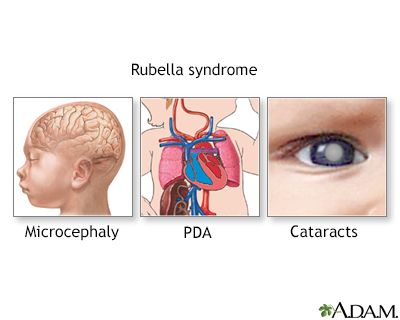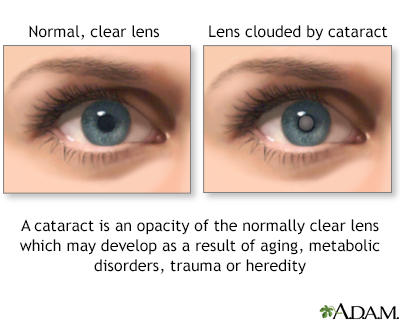Congenital cataract
Cataract - congenital
A congenital cataract is a clouding of the lens of the eye that is present at birth. The lens of the eye is normally clear. It focuses light that comes into the eye onto the retina.
Images




I Would Like to Learn About:
Causes
Unlike most cataracts, which occur with aging, congenital cataracts are present at birth.
Congenital cataracts are rare. In most people, no cause can be found.
Congenital cataracts often occur as part of the following birth defects:
- Chondrodysplasia syndrome
- Congenital rubella
- Conradi-Hünermann syndrome
- Down syndrome (trisomy 21)
- Ectodermal dysplasia syndrome
- Familial congenital cataracts
- Galactosemia
- Hallermann-Streiff syndrome
- Lowe syndrome
- Marinesco-Sjögren syndrome
- Pierre-Robin syndrome
- Trisomy 13
Symptoms
Congenital cataracts most often look different than other forms of cataract.
Symptoms may include:
- An infant does not seem to be visually aware of the world around them (if cataracts are in both eyes)
- Gray or white cloudiness of the pupil (which is normally black)
- The "red eye" glow (red reflex) of the pupil is missing in photos, or is different between the 2 eyes
- Unusual rapid eye movements (nystagmus)
Exams and Tests
To diagnose congenital cataract, the infant should have a complete eye exam by an ophthalmologist. The infant may also need to be examined by a pediatrician who is experienced in treating inherited disorders. Blood tests or x-rays may also be needed.
Treatment
If congenital cataracts are mild and do not affect vision, they may not need to be treated, especially if they are in both eyes.
Moderate to severe cataracts that affect vision, or a cataract that is in only 1 eye, will need to be treated with cataract removal surgery. In most (noncongenital) cataract surgeries, an artificial intraocular lens (IOL) is inserted into the eye. The use of IOLs in infants is controversial. Without an IOL, the infant will need to wear a contact lens.
Patching to force the child to use the weaker eye is often needed to prevent amblyopia.
The infant may also need to be treated for the inherited disorder that has caused the cataracts.
Outlook (Prognosis)
Removing a congenital cataract is usually a safe, effective procedure. The child will need follow-up for vision rehabilitation. Most infants with congenital cataract in one eye have some level of "lazy eye" (amblyopia) and will need to use patching after the surgery in an attempt to reverse it.
Possible Complications
With cataract surgery there is a very slight risk of:
- Bleeding
- Infection
- Inflammation
Infants who have surgery for congenital cataracts are likely to develop another type of cataract, which may need further surgery or laser treatment.
Many of the diseases that are associated with congenital cataract can also affect other organs.
When to Contact a Medical Professional
Call for an urgent appointment with your baby's health care provider if:
- You notice that the pupil of one or both eyes appears white or cloudy.
- The child seems to ignore part of their visual world.
Prevention
If you have a family history of inheritable disorders that could cause congenital cataracts, consider seeking genetic counseling.
Related Information
Cataract - adultGalactosemia
Rubella
Trisomy 13
Ectodermal dysplasias
References
Cioffi GA, Liebmann JM. Diseases of the visual system. In: Goldman L, Cooney KA, eds. Goldman-Cecil Medicine. 27th ed. Philadelphia, PA: Elsevier; 2024:chap 391.
Lambert SR, Cotsonis G, DuBois L, et al; Infant Aphakia Treatment Study Group. Long-term effect of intraocular lens vs contact lens correction on visual acuity after cataract surgery during infancy: a randomized clinical trial. JAMA Ophthalmol. 2020;138(4):365-372. PMID: 32077909 pubmed.ncbi.nlm.nih.gov/32077909/.
Lambert SR, Wilson ME Jr, Plager DA, Lloyd IC. Update on pediatric cataracts. AAPOS Webinar. May 12, 2017. www.aao.org/annual-meeting-video/update-on-pediatric-cataracts. Accessed September 28, 2023.
Örge FH. Examination and common problems in the neonatal eye. In: Martin RJ, Fanaroff AA, Walsh MC, eds. Fanaroff and Martin's Neonatal-Perinatal Medicine. 11th ed. Philadelphia, PA: Elsevier; 2020:chap 95.
Senna I, Piller S, Ben-Zion I, Ernst MO. Recalibrating vision-for-action requires years after sight restoration from congenital cataracts. Elife. 2022;11:e78734. PMID: 36278872 pubmed.ncbi.nlm.nih.gov/36278872/.
Wevill M. Epidemiology, pathophysiology, causes, morphology, and visual effects of cataract. In: Yanoff M, Duker JS, eds. Ophthalmology. 6th ed. Philadelphia, PA: Elsevier; 2023:chap 5.5.
BACK TO TOPReview Date: 8/4/2023
Reviewed By: Franklin W. Lusby, MD, Ophthalmologist, Lusby Vision Institute, La Jolla, CA. Also reviewed by David C. Dugdale, MD, Medical Director, Brenda Conaway, Editorial Director, and the A.D.A.M. Editorial team.

Health Content Provider
06/01/2025
|
A.D.A.M., Inc. is accredited by URAC, for Health Content Provider (www.urac.org). URAC's accreditation program is an independent audit to verify that A.D.A.M. follows rigorous standards of quality and accountability. A.D.A.M. is among the first to achieve this important distinction for online health information and services. Learn more about A.D.A.M.'s editorial policy, editorial process and privacy policy. A.D.A.M. is also a founding member of Hi-Ethics. This site complied with the HONcode standard for trustworthy health information from 1995 to 2022, after which HON (Health On the Net, a not-for-profit organization that promoted transparent and reliable health information online) was discontinued. |
The information provided herein should not be used during any medical emergency or for the diagnosis or treatment of any medical condition. A licensed medical professional should be consulted for diagnosis and treatment of any and all medical conditions. Links to other sites are provided for information only -- they do not constitute endorsements of those other sites. © 1997- 2025 A.D.A.M., a business unit of Ebix, Inc. Any duplication or distribution of the information contained herein is strictly prohibited.
